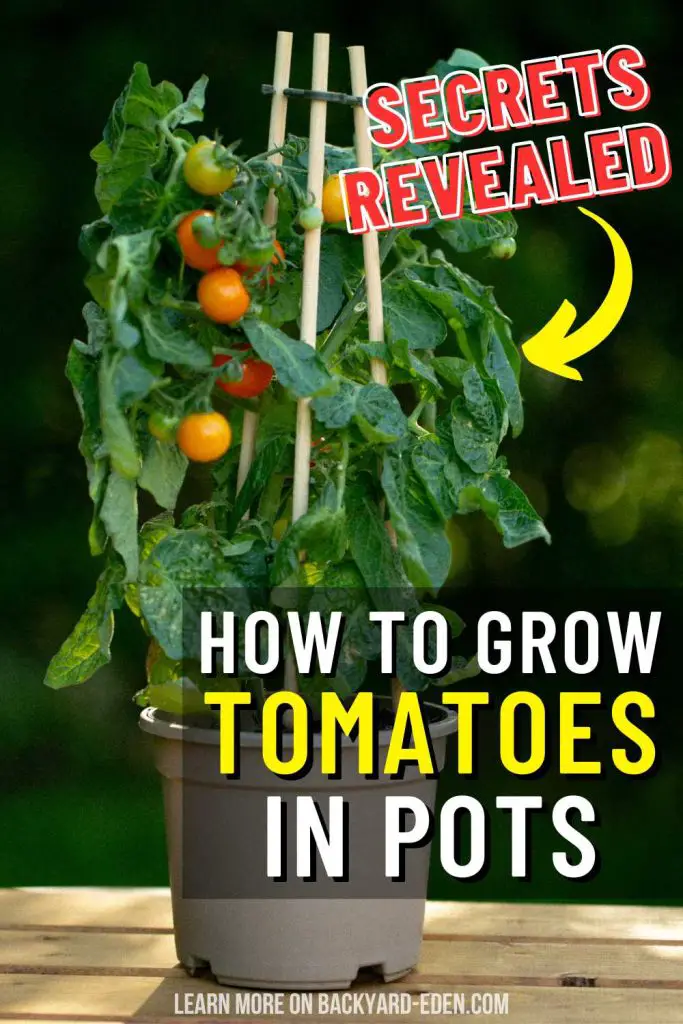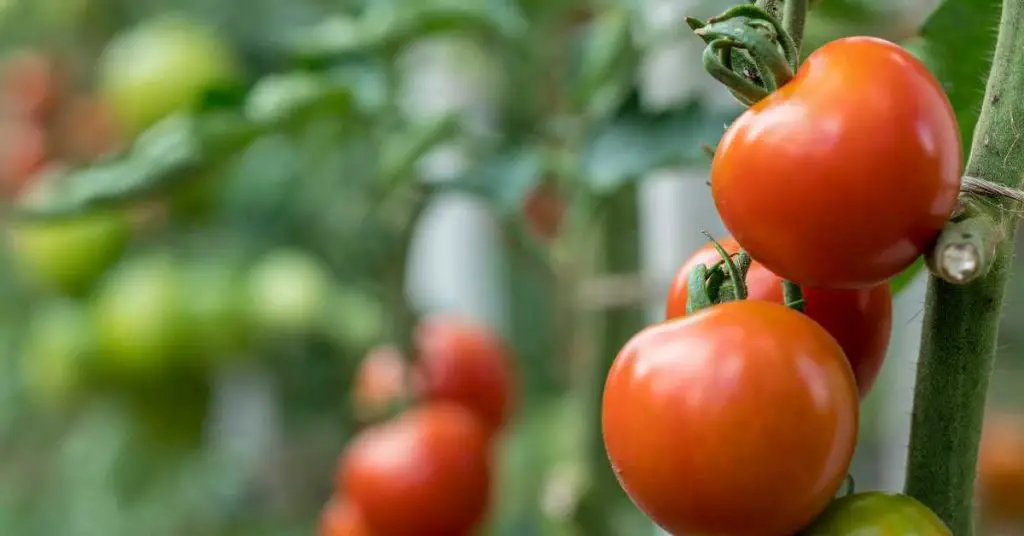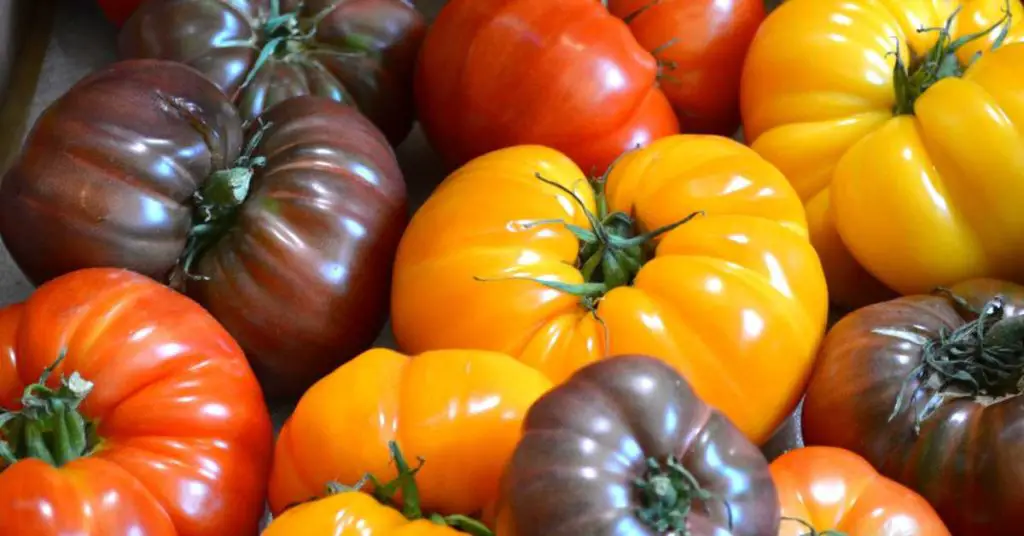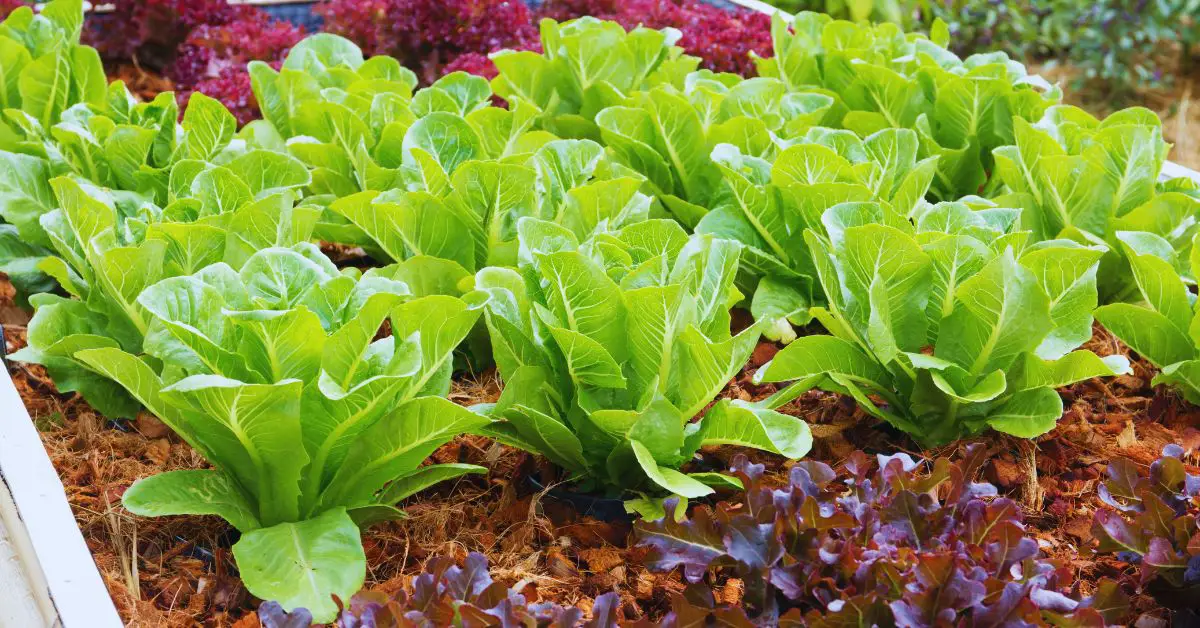Growing tomatoes in pots is a fantastic way to enjoy fresh, juicy fruits right from your balcony or patio. This method is perfect for those who have limited space or live in urban areas. Potted tomatoes can be just as bountiful as those grown in a garden bed, but they require a bit less work and can be moved if needed.
Tomatoes are one of the most popular plants to grow at home because they are both tasty and healthy. By choosing to grow them in pots, you have the flexibility to control their environment more effectively. This includes managing sunlight, water, and nutrients, which can lead to healthier plants and better yields.
In this guide, we’ll explore everything you need to know about growing tomatoes in pots. From selecting the right varieties and pots to the care and harvesting of your plants, we’ll cover all the steps to help you grow delicious tomatoes right on your porch or in any small space. Let’s dive into the world of Container Tomato Gardening and discover how enjoyable and rewarding it can be!

This post may contain affiliate links. Read our full disclosure here.
Choosing the Right Tomato Variety
When growing tomatoes in pots, picking the right variety is crucial. There are two main types of tomato plants to consider: determinate and indeterminate.
Determinate tomatoes
Also known as bush tomatoes, grow to a compact height and typically stop growing when fruit sets on the top bud. All the tomatoes from this plant ripen around the same time, which is great if you want a bunch of tomatoes all at once. These varieties are ideal for containers due to their more manageable size.
Indeterminate tomatoes
These continue to grow and produce fruit throughout the growing season. They usually require more space and support but can provide a steady supply of tomatoes.
For container gardening, compact or dwarf varieties work best. Here are a few good choices:
- ‘Patio Princess’ – This is a true container variety, growing about 18 inches tall and producing flavorful, medium-sized tomatoes.
- ‘Tiny Tim’ – A very small, cherry-type tomato that works well in even the smallest pots.
- ‘Balcony’ – Known for its use in balcony gardens, this variety produces good yields of small, tasty tomatoes.
- ‘Micro Tom’ – This variety only gets to about 8 inches or so and produces delicious little micro tomatoes.
These varieties are not only suited for the limited space of pots but also tend to require less maintenance than larger plants, making them perfect for beginner gardeners or those looking for convenience.

Selecting the Appropriate Pot
Choosing the right pot is a key step in successfully growing tomatoes in containers. The size of the pot is particularly important, as it needs to be large enough to support the plant’s growth.
Ideal Pot Size: For most tomato plants, a pot that holds at least 5 gallons of soil is necessary. This size ensures there is enough room for the roots to grow and support a healthy plant. Larger varieties may require even bigger pots, up to 10-15 gallons.
Drainage Is Crucial: Make sure your pot has adequate drainage holes at the bottom. Good drainage is essential to prevent water from pooling at the roots, which can lead to root diseases like root rot.
Material Matters: Pots can be made from various materials, each with its pros and cons:
- Clay Pots are porous, which helps prevent waterlogging and keeps the soil cool. However, they can be heavy and break easily.
- Plastic Pots are lightweight and retain moisture well, but they can deteriorate under sunlight and may not be as breathable as other materials.
- Fabric Pots are a newer option that allows air to reach the roots, promoting healthy growth and preventing overwatering.
When setting up your pot, consider placing it on a platform with wheels if it’s large and heavy. This setup will make it easier to move the pot around to capture the best sunlight throughout the day.
Soil and Fertilization
Soil Selection: The right potting mix is essential for growing healthy tomatoes in containers. Use a high-quality potting soil that is light and fluffy. It should be able to retain moisture without becoming waterlogged. Avoid using garden soil as it can be too heavy and may contain disease pathogens.
Enriching the Soil: To help your tomatoes thrive, enrich the potting mix with compost or a well-balanced organic matter. This addition improves soil fertility and structure, which supports plant growth and fruit development.
Fertilization Needs: Tomatoes are heavy feeders, which means they benefit greatly from regular fertilization. Use a balanced, slow-release fertilizer that includes nitrogen, phosphorus, and potassium. Apply this according to the package directions, typically every four to six weeks.
Key Nutrients:
- Nitrogen helps with leaf and stem growth.
- Phosphorus is crucial for root development and helps flowers and fruits form.
- Potassium aids in overall plant health and disease resistance.
For an organic approach, consider using fish emulsion, seaweed extract, or compost tea. These organic options feed the plant while also enriching the soil with beneficial microbes.
Monitoring Nutrient Levels: Since watering can cause nutrients to leach out of the pot, it’s important to monitor the soil’s fertility regularly. If the leaves start to turn yellow or the growth seems stunted, it might be time to add a bit more fertilizer. However, be careful not to over-fertilize, as this can lead to excess leaf growth at the expense of fruit production.
Planting Your Tomatoes
Step 1: Choosing Seedlings or Seeds: Decide whether you want to start your tomatoes from seeds or purchase seedlings from a nursery. Seedlings are a convenient option for beginners as they are already established and ready to transplant into pots. If you choose to grow from seeds, start them indoors 6-8 weeks before the last frost date in your area.
Step 2: Preparing the Pot: Fill your chosen pot with the appropriate potting mix, leaving about 2 inches of space from the top. Ensure the pot has drainage holes at the bottom to prevent waterlogging.
Step 3: Planting Depth and Spacing: If transplanting seedlings, dig a hole in the potting mix deep enough to accommodate the root ball of the seedling. Gently remove the seedling from its container and place it in the hole, covering the roots with soil. If planting seeds, follow the instructions on the seed packet for proper planting depth and spacing.
Step 4: Watering and Settling: After planting, water the soil thoroughly to help settle it around the roots. This also ensures good contact between the roots and the soil. Avoid compacting the soil too much, as this can restrict root growth.
Step 5: Placement and Sunlight: Place the pot in a location that receives at least 6-8 hours of direct sunlight per day. Tomatoes love warmth and sunlight, so choose a sunny spot on your balcony or patio.
Step 6: Mulching (Optional): Consider adding a layer of mulch around the base of the plant to help retain moisture and suppress weeds. This is especially beneficial in hot and dry climates.
Step 7: Watering Schedule: Maintain a consistent watering schedule, ensuring the soil remains evenly moist but not waterlogged. Check the moisture level regularly by inserting your finger into the soil. If it feels dry about an inch below the surface, it’s time to water again.
By following these steps, you’ll give your tomato plants the best start in their new container home.
Sunlight and Watering Needs
Sunlight Requirements: Tomatoes thrive in full sunlight, so it’s essential to provide them with at least 6-8 hours of direct sunlight per day. Choose a sunny location for your pots, such as a south-facing balcony or patio, where they can soak up the sun’s rays.
Understanding Watering Needs: Proper watering is crucial for the health and productivity of your tomato plants. Tomatoes need consistent moisture to grow and produce fruits, but they also don’t like to sit in soggy soil. Here are some key points to remember:
- Frequency: Water your tomato plants deeply but less frequently. Aim to water them whenever the top inch of soil feels dry to the touch. This may mean watering every 1-3 days, depending on the weather and pot size.
- Avoid Overwatering: Overwatering can lead to root rot and other problems. Always check the soil moisture before watering and adjust your watering schedule accordingly.
- Watering Techniques: Water your plants at the base rather than from overhead to prevent water from splashing onto the leaves, which can promote disease. Use a watering can or drip irrigation system for precise watering.
Monitoring Moisture Levels: Get into the habit of checking the soil moisture regularly, especially during hot and dry weather. Stick your finger into the soil to feel for moisture. If it feels dry, it’s time to water. If it feels moist, hold off on watering until the soil dries out a bit more.
By providing adequate sunlight and watering your tomato plants properly, you’ll ensure they have the best chance of thriving and producing a bountiful harvest.
Staking and Support
Importance of Support: As tomato plants grow, they can become heavy with fruit, causing the branches to bend or even break. Providing support for your tomato plants is essential to prevent this and to keep the fruits off the ground, reducing the risk of rot and pest damage.
Different Support Options: There are several options for supporting tomato plants in pots:
- Cages: Tomato cages are easy to use and provide 360-degree support for the plant. They can be inserted into the pot at the time of planting or added later as the plant grows.
- Stakes: Wooden or metal stakes can be driven into the soil near the base of the plant and tied to the main stem as the plant grows. This provides vertical support and helps keep the plant upright.
- Trellises: Trellises are a vertical support structure that allows the tomato plant to climb as it grows. They can be made from wood, metal, or even bamboo and provide excellent support for indeterminate tomato varieties.
Proper Installation: Whatever support method you choose, make sure it is installed securely and early in the plant’s growth stage. This helps prevent damage to the roots or stems when the plant is larger.
Tying and Pruning: As the tomato plant grows, you may need to tie it to the support structure to keep it upright. Use soft ties or twine to avoid damaging the stems. Additionally, regular pruning of suckers (the small shoots that grow between the main stem and branches) can help keep the plant tidy and focused on fruit production.
By providing adequate support for your tomato plants, you’ll help them grow tall and strong, leading to a more abundant harvest of delicious tomatoes.
Pest and Disease Management
Common Pests: Tomatoes are susceptible to various pests that can damage the plants and reduce yield. Some common pests include:
- Aphids: These small insects feed on the sap of the plant, causing stunted growth and curled leaves.
- Whiteflies: Whiteflies are tiny, flying insects that suck sap from the leaves, causing them to turn yellow and wilt.
- Tomato Hornworms: These large caterpillars can quickly defoliate a tomato plant if not controlled.
Disease Prevention: Tomatoes are also prone to diseases such as:
- Blight: A fungal disease that causes dark, water-soaked lesions on leaves and stems.
- Leaf Spot: Another fungal disease characterized by dark spots on the leaves, which can eventually cause them to yellow and drop off.
Organic Pest Control: To manage pests and diseases in your tomato plants, consider using organic methods such as:
- Handpicking: Remove pests like hornworms by hand and drop them into a bucket of soapy water to drown.
- Neem Oil: Neem oil is a natural insecticide and fungicide that can help control aphids, whiteflies, and fungal diseases.
- Beneficial Insects: Introduce beneficial insects like ladybugs and lacewings, which prey on aphids and other pests.
Cultural Practices: Good gardening practices can also help prevent pest and disease problems:
- Crop Rotation: Avoid planting tomatoes in the same spot year after year to reduce the buildup of soil-borne diseases.
- Sanitation: Keep the garden clean and free of debris, which can harbor pests and diseases.
Early Detection and Treatment: Regularly inspect your tomato plants for signs of pests or diseases. If you notice any problems, take action immediately to prevent them from spreading. Remove affected leaves or plants and treat with organic remedies as needed.
By practicing good pest and disease management techniques, you can help keep your tomato plants healthy and productive throughout the growing season.
Harvesting Your Tomatoes
Determining Ripeness: Knowing when to harvest your tomatoes is crucial for enjoying them at their peak flavor and texture. Here are some signs to look for:
- Color: Most tomato varieties will change color as they ripen, typically from green to red, yellow, or another specified color. However, this can vary depending on the variety, so refer to the seed packet or plant tag for guidance.
- Texture: Ripe tomatoes should have a slight give when gently squeezed but still feel firm.
- Appearance: Fully ripe tomatoes will often have a glossy sheen and uniform color.

Harvesting Techniques:
- Handpicking: Gently twist or cut the tomato from the stem using a pair of clean scissors or pruning shears. Be careful not to damage the stem or nearby fruits.
- Timing: It’s best to harvest tomatoes in the morning when temperatures are cooler, and the fruits are at their peak flavor and juiciness.
Storing Fresh Tomatoes:
- Room Temperature: If you plan to use your tomatoes within a few days, store them at room temperature away from direct sunlight. This allows them to ripen fully and develop maximum flavor.
- Refrigeration: If you have more tomatoes than you can use immediately, you can store them in the refrigerator for up to a week. However, refrigeration can affect the texture and flavor of tomatoes, so it’s best to use them as soon as possible.
Avoiding Bruising and Damage:
- Handle tomatoes carefully to avoid bruising or puncturing the skin, which can lead to spoilage.
- Store harvested tomatoes in a single layer to prevent them from pressing against each other and causing bruising.
Enjoying Your Harvest: Once harvested, enjoy your tomatoes fresh in salads, sandwiches, or as a simple snack. They can also be preserved by canning, freezing, or drying for later use, allowing you to enjoy the taste of summer all year round.
Maintenance and Seasonal Care
Regular Maintenance Tasks: To ensure healthy growth and abundant harvests, it’s essential to stay on top of maintenance tasks throughout the growing season. Here’s what you need to do:
- Pruning: Regularly remove suckers, which are small shoots that grow in the leaf axils of tomato plants. This helps improve airflow around the plant and redirects energy to fruit production.
- Removing Yellow Leaves: Monitor your plants for yellowing or diseased leaves and promptly remove them to prevent the spread of disease.
- Feeding: Continue to fertilize your tomato plants every 4-6 weeks with a balanced fertilizer to provide them with essential nutrients for growth and fruit production.
- Watering: Maintain a consistent watering schedule, ensuring the soil remains evenly moist but not waterlogged. Adjust your watering frequency based on weather conditions.
- Mulching: Consider adding a layer of organic mulch, such as straw or shredded leaves, around the base of your tomato plants to help retain moisture, suppress weeds, and regulate soil temperature.
Seasonal Care:
- Summer: As temperatures rise, monitor your plants closely for signs of heat stress, such as wilting or leaf curling. Provide shade during the hottest part of the day if necessary and water more frequently to prevent drought stress.
- Fall: As the growing season comes to an end, harvest any remaining tomatoes before the first frost. Consider covering your plants or bringing them indoors if frost is imminent to prolong the harvest.
- Winter: In colder climates, protect perennial tomato varieties by insulating their pots with mulch or moving them to a sheltered location. Prune back any dead or damaged foliage to encourage new growth in the spring.
By staying vigilant with maintenance tasks and providing seasonal care, you can help your tomato plants thrive and continue to produce delicious fruits throughout the growing season.
FAQs
Can I Grow Tomatoes in Pots Indoors?
Yes, you can grow tomatoes in pots indoors, but it’s important to provide them with adequate light. Tomatoes require at least 6-8 hours of direct sunlight per day to thrive. If you don’t have access to sufficient natural light, you can supplement with artificial grow lights.
Make sure your indoor space is well-ventilated to prevent humidity-related issues and promote airflow around the plants. Choose compact tomato varieties suited for container gardening, and consider using self-watering pots to help maintain consistent moisture levels.
With proper care and attention to light and growing conditions, you can successfully grow tomatoes indoors.
How Often Should I Water My Potted Tomato Plants?
The frequency of watering your potted tomato plants depends on several factors, including the weather, pot size, and stage of growth. As a general guideline, water your tomato plants whenever the top inch of soil feels dry to the touch.
In hot, dry weather, you may need to water more frequently, while cooler, rainy conditions may require less frequent watering. Avoid overwatering, as this can lead to root rot and other problems. Instead, aim to keep the soil evenly moist but not waterlogged.
Regularly monitor the soil moisture and adjust your watering schedule as needed to ensure the plants receive the right amount of water for healthy growth.
Do I Need to Prune My Potted Tomatoes?
Yes, pruning is beneficial for potted tomato plants as it helps improve airflow, reduce disease risk, and encourage fruit production. Remove suckers, which are small shoots that grow in the leaf axils, to redirect the plant’s energy toward fruit production.
You can also remove any yellowing or diseased leaves to prevent the spread of disease and promote overall plant health. Consider pruning the main stem to remove any excessive growth that may shade lower branches.
However, be careful not to over-prune, as this can reduce the plant’s ability to produce fruit. Aim to strike a balance between maintaining a healthy plant structure and maximizing fruit yield.
What Should I Do If My Tomato Plants Start to Lean or Tip Over?
If your tomato plants start to lean or tip over, it’s essential to provide them with proper support to prevent further damage. Install stakes, cages, or trellises early in the growing season to support the plants as they grow.
Make sure the support structure is securely anchored in the soil and tall enough to accommodate the plant’s height. If the plant continues to lean, check for root-bound issues or adjust the pot’s location to provide better balance and stability.
Avoid propping up the plant with makeshift supports, as this can lead to further damage. By providing adequate support and addressing any underlying issues, you can help your tomato plants grow upright and healthy.
Can I Reuse Potting Soil From One Year to the Next for Tomatoes?
While it is possible to reuse potting soil from one year to the next, it’s not recommended. Over time, potting soil can become depleted of nutrients and may harbor disease pathogens or pests.
Reusing soil can also lead to compaction and poor drainage, which can affect plant health and growth. Instead, it’s best to refresh the potting mix each year by adding fresh compost or organic matter to replenish nutrients and improve soil structure.
Make sure to thoroughly clean and sanitize the pots before planting to reduce the risk of disease transmission.
By using fresh potting soil each year, you’ll provide your tomato plants with the best possible growing environment for healthy growth and abundant harvests.
Conclusion
Growing tomatoes in pots is a rewarding experience that allows you to enjoy fresh, homegrown produce even in small spaces. By following the steps outlined in this guide, you can successfully grow tomatoes right on your balcony, patio, or even windowsill.
From selecting the right varieties and pots to providing proper care and maintenance, you’ve learned everything you need to know to get started with container tomato gardening. Whether you’re a beginner or experienced gardener, there’s always something new to discover and experiment with in the world of growing tomatoes.
So, roll up your sleeves, grab your gardening gloves, and get ready to enjoy the satisfaction of harvesting your own juicy, flavorful tomatoes. Whether you slice them for sandwiches, toss them in salads, or simply enjoy them fresh off the vine, there’s nothing quite like the taste of homegrown tomatoes.





